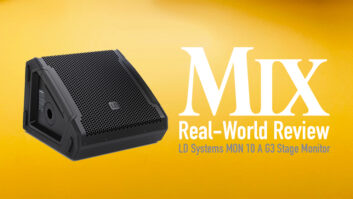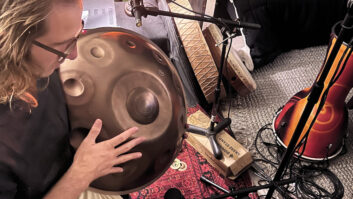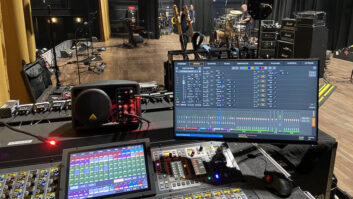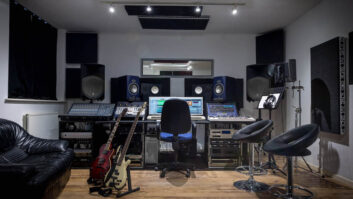Invariably, it’s a song’s lyrics and melody that most obviously and immediately grab the listening public’s attention. But often, as any good music producer knows, what really drives a piece of music is its bass line. That’s what sets the tone, lays down the groove, complements the melody and leads you through the song. But because bass resides in a certain narrowly prescribed area of the audio spectrum, it’s often difficult to capture it properly when recording. Those low frequencies take up a lot of air space; if you don’t get it right, then you won’t hear them. Conversely, if you get too much of them, then you’re left with mud. Given small control rooms, recording gear that’s less than full frequency and, according to some, the proliferation of digital, well, getting a great bass sound can be challenging, to say the least. Searching for fresh insight into the process of recording this all-important instrument, Mix rounded up some experts and asked them to share their thoughts, theories and tips.
RIK PEKKONEN
Los Angeles-based engineer Rik Pekkonen’s discography extends over 30 years and includes records with The B-52’s, Booker T. & The MG’s, Garth Brooks, Larry Carlton, B.B. King, Lyle Lovett, Ziggy Marley, Aaron Neville, Roy Orbison, Ricky Martin, Joe Sample, Gillian Welch and 11 releases by soul jazz legends The Crusaders. When I caught up with him, he was working with producer Stewart Levine, finishing a very funky album of New Orleans soul by Dr. John.
Pekkonen phrases the bottom line succinctly: “The bass is the soul of the record. It’s also the most elusive element.” Aware of the complexity of the challenge, he strives for simplicity in recording and straight-ahead equipment choices. “Ninety-nine percent of the time,” he says, “we use the direct signal. I’ll choose a Demeter tube direct box for that. If we use an amp, I’ll use a Neumann U47 tube, a Neumann 47 FET, a Sony 55P or a Sennheiser 421 microphone on it. I’ll isolate the amp in a booth or, if it’s in the main room with other musicians, I’ll baffle it off. I place the mic four or five inches away from the speaker and off-center. Sometimes the bass player will have a favorite spot on the speaker, so it’s always good to ask. If you aren’t able to record an amp, you can always put the direct signal through one later. Just send it through the cue system [using the cue pot for gain control] and, over a tie line, into an amp.”
If there’s a choice of amp, Pekkonen prefers an Ampeg B15. “It’s so versatile,” he notes. “A good bass player with the correct bass can get jazz, rock, pop, R&B — and more — sounds easily. Of course, the absolute best thing is to get someone like Abe Laboriel, Freddie Washington Jr., Nathan East, Reggie McBride, Hutch Hutchinson or Darryl Jones who can not only can play great, get a great sound and have just the right bass for the song, but are also great guys and easy to work with. If something isn’t right on the first run-through or so, they’ll take another approach. They’re always open to suggestions on how to make it right.”
Whether Pekkonen limits the bass signal from the get-go or not is determined by what he knows about the bass player and his or her playing style. Whenever possible, he also discusses the desired sound with the producer, artist and/or bass player before determining what kind of signal processing will be applied.
“For limiters,” he comments, “I like [UREI] 1176, dbx 160 and Teletronix LA-2As. If you want superduper limiting because the part is incredibly dynamic and all over the place, use a Fairchild. If you need something more rock ‘n’ roll transistor-sounding, use an 1176. dbx 160s have more top end, and an LA-2A gives you a warmer tube sound. I don’t usually do too much limiting on the way in — I want to be able to change my mind. If it’s already too limited, you can’t change it.”
Busy tracks with lots of instruments fighting for space are an everyday challenge for engineers who must struggle to find the right sound for each instrument. “Simplicity is the answer,” Pekkonen advises. “Signal processing to make the bass sound a little ‘alien’ so it stands out in the track and isn’t so homogeneous might work. You can signal-process a bass to sound very unlike a normal bass to where you go, ‘What’s that?’ so that it makes its own space. Whether it actually works in the track or not is a different question, but it’s worth a try.”
Pekkonen’s First Commandment of good bass recording? “Know your speakers!”
TONY LEVIN
Bass virtuoso Tony Levin is perhaps best known for his work with Peter Gabriel for the past 25 years, including Gabriel’s masterpiece, So. At another end of the spectrum are his more than 20 records with King Crimson and his playing on releases by David Bowie, John Lennon, Alice Cooper, Tracy Chapman, Paula Cole, James Taylor and Warren Zevon, as well as on his own four albums, the most recent of which is Pieces of the Sun.
“The most important function of a bass sound is to enhance the style of the music and of the part,” states Levin by phone from his home in upstate New York. “Historically, some prime examples are Paul McCartney’s woody/muted sound in The Beatles; Tim Bogert’s bass-y, melodic playing in Vanilla Fudge; Chris Squire’s trebly, melodic sound; and all the Motown-style, clean, clear Fender sounds. Ultimately, the sound of the bass is dependent on who’s playing it. There are a tremendous number of things that the player can do to change it: phrase things differently, pluck a string differently, have a different attack or use their fingers in a different way to make the notes shorter or longer.
“These days, with lots of synthesized instruments filling in the low end, listeners are getting used to hearing a great deal more low frequency in the music and I’ve found myself trying to squeeze more lows out of my instruments. I also take note when I hear it done in an effective way on CDs. Even if it’s a synth, if it’s doing an effective job, it may have some effect on how I’ll react to the next music I’m part of.”
How has Levin added more low end to his sound? “By getting a new bass with more lows,” he says with a laugh. “You only have what’s there [on the bass]; it’s not a matter of just boosting a single frequency. There are good, usable low frequencies and there are the kind of frequencies that are going to get mixed out of the record. I mostly play Music Man basses. They’ve always been bassier with more punchy, usable low end.”
Levin also finds that he gets more lows by playing “a little further up on the string, farther away from the bridge” and — while he says engineers debate with him on this — by dampening the strings, either with a bass’ built-in dampers or with padding. “I’ve been told it doesn’t make sense,” he says with a laugh, “but to me, it sounds bassier. My classic example is on Peter Gabriel’s ‘Don’t Give Up’ in the middle of the piece, where the feel changes and becomes kind of gospel. I was playing chords on a Music Man that didn’t have dampers built in, and for that section, I wanted to dampen the strings. I’d forgotten my own, so I was looking around the studio for a piece of foam rubber or something to put under the strings. As it happens, I’d brought my newborn daughter to England with me for the sessions, and I’d packed my bass cases full of Pampers. My eye fell on one, and I packed an entire Pamper under the strings. That’s the only difference in the sections of the song: Same bass, same EQ, and while it certainly sounds dampened, it also sounds bassier.”
Although he may use amps for recording sessions, Levin always goes direct, favoring a Radial Engineering JDI DI. “I like its low end and definition,” he notes. “I’ve used it on all the recordings I’ve done in the last few years and on all the live shows. They make a stereo unit that works well for me since I split my bass signal into two for various effects.”
When recording at his home studio, Levin uses the stereo JDI DI with one side fed to a Neve 33122 mic preamp/EQ module and then into Emagic’s Logic software. The other side goes into a Retrospec tube DI, into an Empirical Lab Distressor and then into Logic.
Levin generally brings his rack to recording sessions that are held for a week or more. Compressor-wise, he’ll often choose his Distressor for “clean, studio-quality sparkle.” For heavy rock playing, he uses a prototype Retrospec compressor. “I find the prototype colors the sound slightly more than the finished model in a way that works well for my basses.”
Amp-wise, Levin relies on Trace Elliots or an Ampeg SVT for a “classic, heavy rock sound.” For the appropriate situation — such as the upcoming new King Crimson record that began in April — Levin enjoys pulling out his large collection of effects. Current favorites, which Levin has been “tinkering” with, are Big Muff fuzztones (“If I can keep one working and reasonably quiet!”) and octave dividers: “I’m always trying new ones, but I’ve found EBs to track best for me.
“For Tony’s last record, Pieces of the Sun, which was done very much live,” adds Levin’s engineer Robert Frazza, “we actually used at least six channels: a mono DI for the center, which was basically clean and unaffected, and a stereo one with left and right running through his rack and generally heavily effected. We also took outputs from each DI to his amps.”
The center-channel amp was a 1,000-watt Trace Elliot AH-1000-12 with four 10-inch and one 18-inch speakers. The left and right amps were Trace Elliot 7210H combos with two 10-inch speakers. All mics were Shure Beta 52s, one mic per cabinet, through a Neve console. Frazza places the mics “pretty much straight-on, right on the center of the cone. There’s a blue strip [marker] on the Betas; behind that, everything is rejected. They’re very much for close-miking.”
Frazza’s advice: “Set up so that you have a clear view between the drummer and bass player! And use speakers you know well. I use a cheap pair of Boston Acoustics A60s and after 10 years of using them, they are extremely accurate for me.”
RANDY JACKSON
Long before bassist/producer Randy Jackson became a celebrity as a judge on American Idol, he was one of the most in-demand bass players in pop music, working with everyone from Bruce Springsteen, Bob Dylan and Journey to Aretha Franklin, Whitney Houston, Celine Dion, Mariah Carey and Madonna. These days — in between taping Idol episodes and promoting his new book, What’s Up Dawg? How to Become a Superstar in the Music Business — he still keeps his hand in, often recording at his personal studio, The Dugout.
Before talking gear, I asked Jackson for some opinions on current trends in bass sounds. He brought up two issues: First, a lack of true low end in many current instruments. “It seems like a lot of manufacturers are still hung up on midrange-y-sounding basses,” he observes. “Maybe it’s a holdover from Jaco [Pastorius], who was one of the last real superstar bass soloists. He used the back pickup of the [Fender] Jazz bass, which is a very midrange kind of pickup. That’s brilliant for a certain kind of sound or for soloing, but I haven’t heard that many bass solos on the radio lately. These days, it can be tough to get the right kind of bottom end. Part of the reason is the instruments themselves, part of it is digital workstations, part of it is the kind of gear in the recording chain. When you get to the digital realm, it’s sometimes really hard to feel the low end. That’s why so many people have gone back to using some kind of tube device in the chain.”
A producer with years of experience in major-label A&R, Jackson’s musical roots as part of the rhythm section give him his unique perspective on sound. “My biggest pet peeve lately,” he notes, “is that too many engineers and mixers decide that either the kick drum or the bass is going to be the bottom end of the record. They choose one or the other, and that makes the end product suffer. On the great old records, everything in the rhythm section worked together to support the bottom end. Great mixers and engineers understand that and find the right place for the drums, bass, keyboards and guitars. They look at the big picture.”
Okay, on to the gear: “Lately,” Jackson says, “people send me their tracks so I can put down a part in my studio. I have a really simple setup so when I’m engineering by myself, I have a chain in place that I know I love the sound of. I rely a lot on my [Line 6] Bass POD Pro. With its physical modeling, it gives me any amp or speaker simulation, and it also has all the effects. I can dial in just about any sound I want. Plus, my basses all have active preamps. So I have the controls on the bass and the POD, and I go into my Yamaha 02R96 console, which I like because it doesn’t add much color. Other times, I’ll just plug straight into the DI input on the front of my Brent Averill [Neve 1272 preamp reissue] and then through the 02R into Pro Tools — or if I’m writing, into Logic. If I need to push any air, I have a little SWR [Mo’Bass] cabinet with a 15-inch speaker and we throw a [Sennheiser] 421 on that.”
Things vary more when Jackson works with his engineer, Kevin Guarnieri. “For clean sounds, we generally use a Demeter tube DI through the Averill 1272 into one side of a [stereo] Neve 33609 compressor,” comments Guarnieri. “It’s one of the ‘real’ 1272s. For clean sounds, a Neve 1073 preamp/EQ module is also great, and I like the Millennia Origin STT-1, which is a mic pre/EQ/compressor with the mic pre and compressor switchable from solid-state to tube. For bass, that’s a great mic pre because you can get so many different tones out of it.
“Randy often uses his Bass POD Pro, but for a more aggressive guitar tone with some growl and cut, he’ll play through a Guitar POD or through the TC Electronic G4 guitar box. Or sometimes I’ll overdrive a mic pre or a compressor or two — or both! For example, on an SSL 4000 or 6000 console, I’ll come out of the insert on one channel, patch back into the mic pre on another channel and then send it out direct through a tube compressor. I love the LA-2A for that: The harmonics on it are fantastic. You start with your output at zero, get your gain reduction in place and then crank up the input until it growls. [Producer/engineer] David Kahne recently turned me on to another good tube limiter: a Federal TV AM-864. Mine was customized for easier input level access and has about 90 dB of gain! You can plug a bass straight in and get a ridiculous tone out of it.”
If Guarnieri gets his druthers, he records an amp with the DI. Sometimes, Jackson will just take a line out of his SWR Mini Mo’ amp head, but whenever possible, Guarnieri prefers to mike speaker cabinets.
Favored mics include Neumann U47s and FET 47s, Sennheiser 421s and Audio-Technica ATM25s. Guarnieri notes, “I’ve got an old Sennheiser 422 [precursor to the 421] that I found on eBay. It’s shorter and fatter and it sounds great.”
To avoid phase problems, Guarnieri usually uses only one mic on a cabinet but will sometimes balance two with a Little Labs IBP phase tool. “If I’m using a 421,” he says, “I poke a flashlight through the screen to find the cone and then I slightly offset the mic from the cone. I’ll point it down where the woofer cap meets the cone and then pull it back a little bit — I want to give it at least a little air. When I use large condensers [U47 or FET 47], I pull them back at least a foot away from the cabinet. Some mics you run into can’t handle that much transience, so you have to be selective.”
The Averill preamp gets used on mics and DIs, but Guarnieri chooses different compressors, often an 1176 chained with an LA-2A. “I’m not double-compressing,” he explains. “The 1176 clamps down and the LA-2A adds coloration and tone. In general, the 1176 is a fantastic compressor, but it’s not full-bandwidth and it can cut out low end and some highs. On bass, I’ll put an equalizer after it to compensate: a GML 8200, Pultec EQP-1 or a Lang PEQ-2. I’ll dump a little bit of supersub and maybe some mid-highs on it from those.”
The two have just completed building a small recording booth, which, Guarnieri says, “is totally Auralex-ed, foamed-out and bass-trapped. It’s totally dead in there — great for the bass cabinets.”
BOB POWER
Acclaimed for his bass sounds, veteran New York producer/engineer Bob Power is also an accomplished guitarist and bassist. Among his credits are multiple projects with The Roots, Me’Shell Ndege’Ocello and A Tribe Called Quest, as well as work with Erykah Badu, India.Arie, David Byrne, D’Angelo and Raphael Saadiq. He was in the middle of mixing Everlast’s new LP when I called.
First off, Power’s listening suggestions: “Lately in heavy rotation on my iPod are Earth, Wind & Fire’s Greatest Hits with their amazing bassist Verdine White,” he says. “Anything by James Jamerson and, of course, there’s Paul McCartney. When I first started recording, I thought he didn’t get a very good bass sound — you know, it’s all woofy and muffy. Now I realize how absolutely brilliant and singular it is, particularly in its very cool midrange approach. Then there’s [producer] Tony Levin’s work on [Peter Gabriel’s] So, which is the benchmark for aggressive. And Me’Shell has a very unique sound. Can’t forget [Charles] Mingus, which is kind of a weird one because, usually, modern recordists think of electric bass and ‘definition.’ When you listen to Mingus, it’s like he’s across the room, but it’s still monstrous — really big.”
Next, the basics: “For logistical reasons, it’s great to plug in a DI and get moving quickly,” Powers affirms, “so that everybody’s energy is happening. But when I’m producing or when there’s time, I like to use DI and amp and I try not to premix them to the same track.” Power’s current favorite DI is an Aguilar DB 900 tube model. “[Aguilar] also makes a bass preamp [the DB680],” he notes, “a two-space, rackmounted, multitube stage preamp. It’s line-level out, which makes life easier. I now bring that and the Aguilar DI everywhere with me.”
A proponent of “less is more” when tracking, Power argues for the virtues of transparency. “My sound is the sound of the artist; I try to see how little I can get away with. I put the signal into a DI, pick whatever preamp is around that’s good or use the Aguilar, and I almost always put a compressor in-line.”
For bass mics, Power grabs Electro-Voice RE20s, Neumann FET 47s and AKG D-12s — “not a D-112, that’s too midrange-y” — with just one mic on a cabinet. “There’s usually not the luxury of time to mess around with mic placement,” he explains. “If you want it a little brighter, move it toward the middle. A little darker, move it toward the edge. Tilt it away and see what off-axis sounds like.”
For preamps, Power reaches for Neves, “which tend to be a little darker. I also have an Avalon 2022, a dual-channel mic pre with a couple of DIs on the front, which is very even and smooth throughout the range. For compression, I usually pop in my Distressor because it’s so adaptable. A lot of guys like dbx 160s on bass, but during tracking, I find them a little severe. And while 1176s are great, you’ve got to be careful: Without too much trouble, you can make one sound really uncomplimentary to the player. You can do that with a Distressor as well if your envelope characteristics are wrong. An attack that’s too fast or a release that’s too slow can take all the life out of a part.”
He continues, “Another thing you have to be aware of is losing frequency response. Compression can suck some of the bottom out. It’s a problem because you want to control the bottom and keep it tight and consistent. Overall, how you use something is more important than what you use. That said, I have a Tube-Tech CL1B, which I love and sounds really good on electric bass. I also have a couple of Pendulum variable-mu compressors, a 6386 and an ES 8, which pretty much sound good every time. And for rock stuff, a dbx 165 is great. Actually, bass is one of the few things that sounds good in it. I always push in the Auto button.”
What about plug-in signal processing? “I’ve gotten over my prejudice. That said, compression is one of the things that plug-ins do the least well. Time-based effects and EQ have gotten better and better in plug-ins, but I still find analog compression is better for bass.”
Power’s advice: “Spend time learning your gear. Beyond that, sit back and listen to the music and not the engineering. It’s a damning acuity when you spend all your life listening really intently and specifically to the sonic side of things. Be careful that it doesn’t ruin your understanding of music on a broad level.”
Maureen Droney is Mix’s Los Angeles editor.
Capturing the Wild Animal: Acoustic Bass
Rik Pekkonen: “The most difficult thing about recording acoustic bass is the situation you’re in. If the bass is live in the room with a rhythm section, you will need a direct output, a mic and baffling. If the bass player insists on a mic only and no baffling and has to be next to the drums — and let’s throw in an aggressive piece of music! — you’ll have every instrument in the room on your bass track.
“After a playback where everyone hates the sound, you’ll get to move the bass into an iso booth or suggest the direct again. Normally, if I don’t know the bass player, I will have all these options set up before the session so we don’t waste time.
“Now you have the bass isolated. Most acoustic bass players don’t like direct bass sounds: It sounds too confining, the EQ is unnatural — the list goes on. A classic tube mic three or four inches away from the instrument and in-between the bridge and the F hole is my traditional placement, but when possible, a Sony 55P mounted underneath the bridge is the best miking technique: When the bass player moves around to the groove of the song, he’s never off-mic.
“With acoustic bass, there will be certain notes that speak more than others; it’s the nature of the beast. Limiting will help the notes be more consistent. The player, the instrument and the song are the real factors to a great acoustic sound. You just have to be ready.”
Bob Power: “Context is everything and modern recordings are a lot about presence. There’s a big difference between listening to an Ellington or a Mingus record with that beautiful big thump from across the room and a modern record with a more present acoustic bass sound. With acoustic bass, a lot of the sonics are determined by the density of what else is going on and how much presence I need to get.
“When I work with someone new, I always ask if there is anything in particular that they love or hate and I’ll explain what I’m doing as I go. I tend to choose really high-end mics for acoustic bass: 47s, either tube or FET, Neumann M49s and 149s, and I’ve also had good luck with my German Brauner VM1. I once did a recording of the Count Basie band with San Francisco engineer Fred Catero. He used a Beyer ribbon mic with a big ball, I think an M500, and it was great.
“More important than what you use is where you put it. I’ll ask the bass player to play and then I’ll walk around the instrument a few times and listen really closely. Sometimes an F hole is good; sometimes the two F holes will be very different-sounding from each other. You may want the mic down by the bridge or up by the fingerboard. Many times, the bass player will say, ‘This is the good spot,’ and they are usually right. If I can, I also like to use a pencil-style condenser in the middle of the bridge, pointing up. If you wrap an AKG 451 or a KM Series mic in either a towel or a piece of foam, you can wedge it pointing up toward the neck, in-between the tailpiece and the body, down at the bottom of the bass. You have to be careful that you don’t wedge it in too tight and dampen the sounding board too much. But if you mix a little bit of that in with the broader mic that you have on the body of the bass, it can really work well.
“For compression, whatever I use I tend to go with a slower attack and release. It’s very easy to mess up acoustic bass because there is so much low end and they tend to be uneven through their range. You may get one note that balloons; it’s just a natural resonant point of the instrument that jumps out. If you hit the compressor wrong, it sounds terrible, so you have to watch it carefully.”







